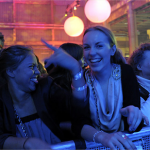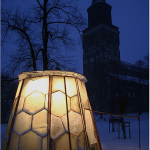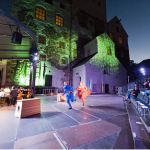10 reasons to visit… Lisbon
Having just come back from Lisbon and having loved every minute of it, I had to continue the ‘10 reasons to visit‘ series with this fantastic city! Here are my thoughts on why you should visit…
1. Cork
I had no idea this was a big Portuguese commodity but apparently Portugal produces well over half the worldwide supply of cork. Presumably because we use less and less cork in bottle stopper production, the Portuguese have become extremely inventive in finding other products to make from the strange bark, and shops in the centre of Lisbon are stuffed full of cork purses, hats, sandals, bags and jewellery – even the odd umbrella!
2. Hills
Some people might disagree with me on this one, but I like a city with hills, and Lisbon is mostly hills. Pretty steep hills. The reason this is good is that it provides lots of great viewpoints, and the view is worth puffing up a hill for. From the top of the Parque Eduardo VII or the Aguas Livres Aqueduct, the view is particularly good, showing a great sweep of pale red rooftops descending into the river estuary. I was staying right at the top of perhaps the steepest hill in town, and climbing up it several times a day made me feel less guilty about having the extra odd pastéis, but if you get fed up with them there’s always the funicular railway to drag you up or down the hill.
3. Pastéis de nata
I really regret not buying a crate of these to bring back. This is definitely the best pastry I’ve ever tasted, and you can get it in every other shop. Gooey, custardy filling inside flaky pastry, slightly burnt like a creme caramel on top. Yum yum yum.
4. Friendly people
I’ve rarely been anywhere where I was made to feel so welcome. Everyone we chatted to had time to talk to us, and everyone was smiley and helpful (a far-cry from London!) Since I work in languages, I always feel guilty not trying to speak the local language a bit so I took uTalk Portuguese with me and managed to get by fairly successfully – but not having practised at all my pronunciation was somewhat questionable. And yet, instead of the scornful expressions you encounter in some places, in Lisbon everyone was patient and happy to listen to me mangling their language. Also, a lot of people addressed me in English before I could even try out my Portuguese – something which impressed me and put me to shame at the same time.
5. Belém
At the far side of the city, the little district of Belem is definitely worth seeing. Its main street is crammed full of bakeries (more pastéis) and small, good-value restaurants selling great seafood dishes. There’s a great big expanse of green park and a long promenade along the seafront, past the impressive statue to Portuguese exploration and the famous Belém Tower. If you’re looking for somewhere to take a book and chill out for an afternoon I recommend Belém!
6. The tram
Lisbon has a set of extremely iconic yellow trams, crammed full of people as they make their rickety way along the streets. Rising very tall off the ground but being very short, they look like little shuffling animals sneaking through the streets. If you’re more of an underground person, the metro has some beautifully decorated stops too – I particularly enjoyed the caricatures at the entrance to the Aeroporto stop.
7. Bacalhau
Aka salted cod. This traditional dish is served for Christmas dinner in some households, and is definitely worth ordering if you get the chance. Historically a fishing nation, the fish and seafood dishes are diverse, imaginative and delicious. I recommend Bacalhau à Gomes de Sá, a mixture of bacalhau, eggs and olives.
8. Cobbled streets
Again, maybe not an actual reason to go to Lisbon, but it’s something really nice when you get there – the streets are all paved with small cubes of white flint which reflect the light so much that it makes you squint. So smooth in places that you slide along them, these cobbles give the roads a charming, uneven surface and make you wonder how long it took to lay all these stones down in the first place.
9. The Elevator of Carmo
I didn’t actually go on this elevator as it seemed a bit of a waste of money, but you can walk along the platform for free and you get another great view over the bustling main street below. The elevator accommodates for the split-level in the street (another consequence of the hilliness) and is built in a fantastic, dark, neo-Gothic style- really imposing.
10. Bairro Alto
The trendy district of Lisbon: we found that it was quite sleepy in the morning and afternoon, but from about 9 at night all the doors open up to reveal tiny, one-room bars selling cheap beer in plastic cups. Everyone meshes together on the streets drinking and chatting, moving from one bar to the next until the dawn creeps in. The whole atmosphere was really friendly and I can’t wait to go back!
Are there any other fans or residents of Lisbon who’d like to share their own reasons to visit? And remember you can send us your own contributions for places to feature in our ’10 reasons to visit’ series 🙂
Nat
10 reasons to visit… Luxembourg
Having just returned from a short trip to Luxembourg, I thought I’d continue with our ’10 reasons to visit’ series by giving you a few reasons why you should consider a trip to this central European country.
Luxembourg may be small, but it’s certainly worth a visit, and here’s why:
1. Great links with the rest of Europe
Luxembourg is just a short, hour-long flight from London, with several airlines and airports serving Lux airport. Our return flights were only £60 with BA. Or you could easily fly or drive from most big cities in Europe. Luxembourg also uses the Euro, which is convenient for other European visitors.
2. It’s quick and easy to visit France/Germany/Belgium
Ok… so my second reason to visit a place probably shouldn’t be that it’s easy to leave it again, but hear me out! I spent five days with a friend who lives in Luxembourg city, and during that time we hopped on the train over to the border to Trier in Germany and Nancy in France for just 10 euros a time. Luxembourg’s central location and small size means it’s easy to get two or three countries for your money by taking a short drive or train ride to one of the nearby cities, and fit as much as possible into your trip.
3. Linguistic diversity
Of course, my next reason has to be language-related! This small country has THREE official languages: Luxembourgish, which is spoken as a mother tongue by almost all residents; French, which is commonly used in restaurants, shops and cafes, and German which is frequently heard in the media. English is also widely spoken. So while you’re there, you can easily practise your French or German, as well as maybe picking up a few phrases of the local language. It was definitely a good opportunity for me to use a bit of French when ordering food and drinks. (By the way, EuroTalk offer all three official languages.)
4. Food and drink
Luxembourgish cuisine is very similar to German/Austrian, with plenty of meat and potato-based dishes. I came across plenty of my favourite German dishes such as Kaesspaetzle (an egg based dish which is a little like pasta or dumplings, with plenty of cheese!), Schnitzel (breaded pork fillets) and Rosti (Swiss-style potato cakes), not to mention Apfelstrudel and cheap beer. But if heavier dishes are not to your taste, there are plenty of French and Italian influenced restaurants in the city as well.
5. Amazing architecture
Luxembourg City used to be a fortress city which was completely surrounded by high stone walls. Those walls are still there, and you can climb to the top and walk around them for an incredible view of the city. The architecture is also beautiful, with many typical cone-shaped roofs and an architectural style that mixes French and German traditions. Planning and building laws in Luxembourg are also much looser than in many other European countries, meaning almost all the houses are built in different styles and colours.
6. Museums and culture
We visited the Luxembourg City History Museum, which is only 3 euro entry, but worth every cent. The museum covers every aspect of Luxembourgish life, from exhibits on the city’s architecture, with models of the city during different periods of its existence, to an entire floor dedicated to shopping and consumer culture, a basement level which is cut into the rock that the city is built on, and loads of fascinating information about the city’s occupation by the Nazis during the WW2 era. It also has great views over the city, especially from the glass lift. The museum is a proper maze and you can get lost in there for hours and find out about all sorts of aspects of Luxembourg City.
7. Landscape and cityscape
Interestingly, the city is built around a huge canyon (for want of a better word!). You must therefore either take one of the city’s many bridges to get to the other side, or you can walk down into the canyon and explore the park, which has a small river and beautiful views. Many people go running or cycling down there, and it’s a great place to chill out or take a walk.
8. Nature is close at hand
The city is full of green spaces, including parks and the river, and you’re never more than short walk from a green area to chill out and relax. However, a short trip outside the city and you’ll be in the midst of the country’s miles and miles of relatively unspoiled countryside. Luxembourg is great for cycling, hiking and fishing or boating. There are also 400 square kilometres of nature parks, many lakes and rivers and miles of cycle routes and hiking trails. As a bonus, the city is also very bike-friendly. You can rent a bike from the Veloh scheme, and there are bike lanes everywhere so you can cycle safely.
9. Shopping!
Unfortunately, Luxembourg isn’t the cheapest place to go on holiday. Wages there are high and the city’s livelihood is largely based on banking. As a result, food prices, for example, are relatively high. However, Luxembourg City and some of the surrounding cities are great places to shop, especially if you’re interested in high-end boutiques and designer labels. If you’re looking for flea markets or bargain hunting then it’s probably not the place for you, but there are several quaint little artisan chocolate, cheese and wine shops, as well as a wide range of designer stores which are worth a look, even if you’re only window shopping.
10. Visit the only remaining grand duchy
Luxembourg is not only one of the smallest sovereign nations in Europe, it’s also the world’s only remaining grand duchy, meaning it’s headed by a grand duke rather than a king/queen or president. You can see the grand duke’s palace in the centre of the city, and his son was recently married in a huge public ceremony which was watched by most of the nation. You can also see the country’s main legislative building, the Chamber of Deputies, right in the city centre.
Alex
Turku – Europe’s Culture Capital 2011

Kökär in the Turku archipelago, one of a series of settings for the Lights Concert Series, part of the Turku 2011 programme. Photo: Esko Keski-Oja
Since 1985, the Council of the European Union has annually chosen a European Capital of Culture, to “highlight the richness and diversity of European cultures”, and to “bring people from different European countries into contact with each other’s culture”. My Finnish hometown of Turku, nestled in the midst of the picturesque archipelago of some 10,000 islands in the Baltic Sea is, along with the beautiful medieval town of Tallinn in Estonia, the European Capital of Culture for 2011.
And what an exciting year it has already been for Turku. Commencing with a spectacular opening ceremony, involving flying dance troupes, hundreds of lantern-bearing school children and a 350-strong choir parading the cobbled streets of Finland’s oldest town, Turku’s 2011 cultural calendar has embraced thousands of individual events, performances and productions.
The individual events have ranged from the beautifully ethereal exhibition 876 Shades of Darkness, contemplating the long dark nights of the Finnish soul, to the alfresco performances of the Opera d’Alvilda in Abo, an Italian opera written in 1692, being performed in the grounds of the imposing Turku Castle.
Historically Turku has embraced culture in all its forms, whether it be through a vibrant music scene centred around two annual music festivals occupying the town centre and nearby island of Ruissalo, or the numerous art and archaeological museums and impressive number of amateur theatres (I counted 13).
This tradition of theatrical performance in Turku is embodied in the rather bulky 60s concrete façade of the much-loved municipal theatre. Offering productions of both homespun and international favourites, the theatre’s Anna Karenina has been extremely well received this year, earning accolades like the prestigious Thalia award for the 2011 Best Theatrical Performance.
Every summer, the spirits of the medieval possess the cobbled streets of Turku’s old town with the Medieval Market fair that habitually attracts around 100,000 visits over four days. Re-enacting everyday street life as as it might have been lived in the alleyways and squares of medieval Turku, this entertaining and informative fair arrives every year, complete with rope twisting competitions, fearful knights and mischievous jesters (see here for a photo album – click on the links on the left to view more pictures).
At the sympathetically restored and historic quayside, an old waterside factory now houses productions by the internationally acclaimed modern dance group Aurinkobaletti.
Next door, the prestigious (and always oversubscribed by aspiring undergraduates) Turku Academy of Art overlooks the symbolic heart of the city, the river Aura. The adjacent city ferry “Föri” takes passengers on a cultural voyage across the river: its distinctive yellow deck has acted as the setting for more than one art performance in the 90 seconds it takes to cross the river.
The 2011 European Capital of Culture award has stimulated Turku’s cultural heritage in new and novel ways, as the variety and sheer volume of productions and performances are acting to bring a new flavour, as well as a renewed vigour, to an already rich cultural landscape.
We must not forget that Turku and Tallinn will pass the mantle of the European Capital of Culture to the towns of Guimarães and Maribor in 2012, and all Turku residents would urge their fellow Europeans to embrace the fascinating cultures of these towns with the same enthusiasm and interest that have been visited upon Turku and Tallinn over the past year. The spirit of the occasion, and the genuine, absolute honour the locals express on being bestowed the award, will stay with Turku for a long time to come.
Hanna
- Kökär in the Turku arcipelago, one of a serios of settings for the Lights Concert Series, part of the Turku 2011 programme. Photo: Esko Keski-Oja
- The opening ceremony of the Turku’s Culture Capital year. Photo: Lauri Paasio
- Festive spirit at the opening celebrations. Photo: Lauri Paasio.
- The opening ceremony of the Turku’s Culture Capital year. Photo: Lauri Paasio
- 876 Shades of Darkness. Photo: Reino Koivula
- Opera d’Alvilda in Abo. Photo: Kari Vainio
- Luostarinmäen käsityöläismuseo / Luostarinmäki Handicrafts Museum. Photo: Johannes Lahti / Turun kaupunki
- Anna Karenina by Turun Kaupunginteatteri. Photo: Robert Seger
- Turku Medieval Market fair. Photo: Esko Keski-Oja
- Tanssiva torni – Dancing tower by Aurinkobaletti. Photo: Kari Vainio
- The town ferry ‘Föri’. Photo Markku Salo – Yle
- A Turku street busker visited by a fan. Photo: Perttu Saksa
- Turku Cathedral at dusk. Photo: Perttu Saksa
























